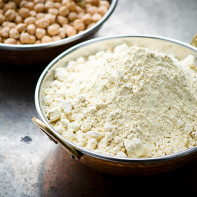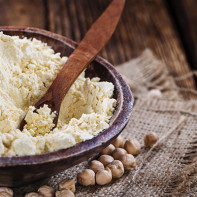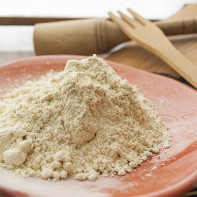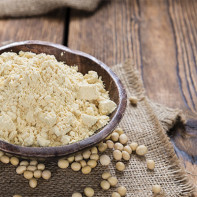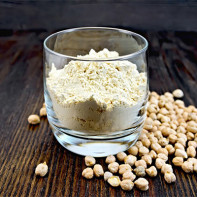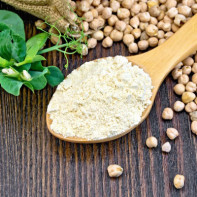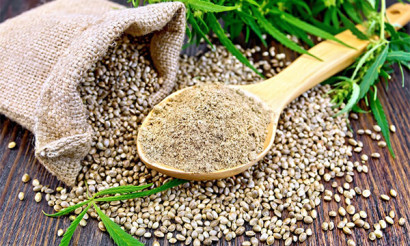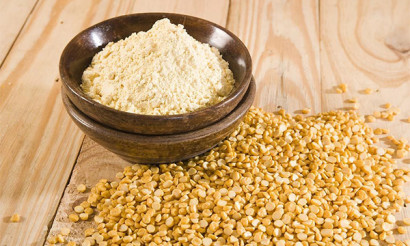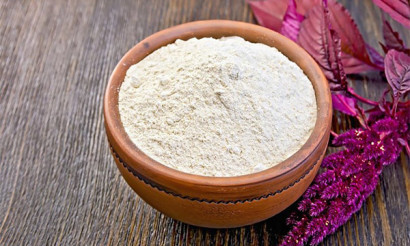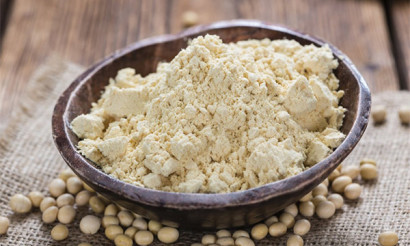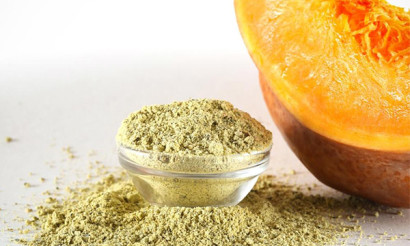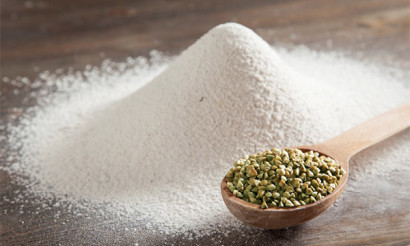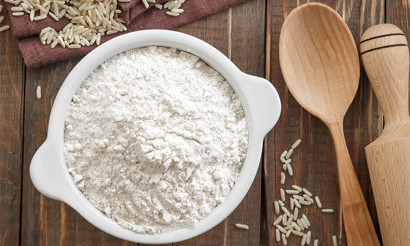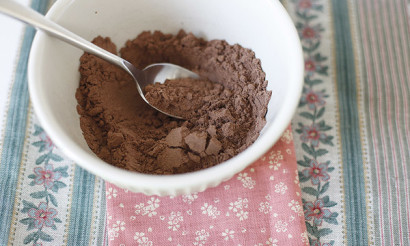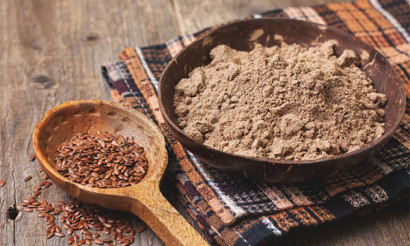Chickpea flour: health benefits and harms
One of the most popular and common legumes in Asia is chickpeas. Therefore, it is not surprising that Besan (flour made from chickpeas) is an incredibly sought-after product that is used in every family.
- Composition and calorie content
- What is useful chickpea flour
- The benefits of chickpea flour for weight loss
- Chickpea flour in medicine
- Chickpea flour in cosmetology
- Harm and contraindications
- How to store chickpea flour
- How to make chickpea flour at home
- What can be prepared from chickpea flour: recipes
- Interesting facts about chickpeas
Composition and calorie content
According to general statistics, chickpea harvest volumes are increasing annually throughout the world, which means that demand for it is regularly growing. Due to its high yield and nutritional value, this crop has become the number one product in the largest and most populous countries, such as India, China, Pakistan, Australia and other smaller countries. What is noteworthy, for sale on the world market, chickpeas are grown only in Australia, in all other countries it is preferably used for domestic needs.
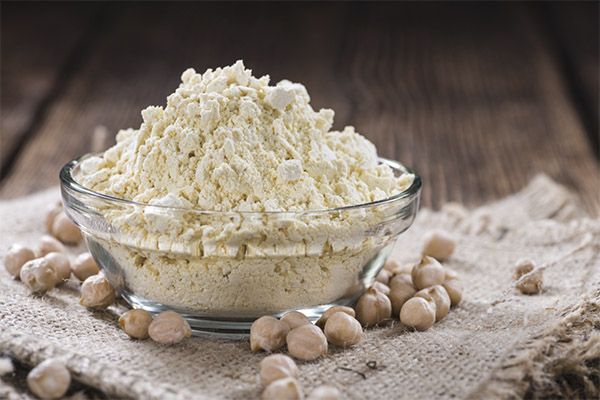
Any bean crop, first of all, is a valuable source of useful vegetable protein, and chickpeas are no exception. That is why chickpea flour is especially popular among people who consciously switch to plant foods and refuse animal products, that is, vegetarians.
100 g of chickpea flour contains about 20 g of useful vegetable protein, up to 5 g of fat and almost 60 g of complex carbohydrates, thanks to which the feeling of fullness can last up to 5-6 hours. Despite the enriched composition and high calorie content (100 g contains about 350 kilocalories), flour is very useful for those who follow their figure and adhere to certain diets. This is justified by the large number of nutrients and minerals in the composition that make it a dietary product.
The biological value of the proteins contained in chickpea flour is not much inferior to that of animal proteins, and therefore products from it can quite easily replace meat dishes without harm to health and the body as a whole. In addition, chickpea flour contains essential amino acids such as lysine, methionine and tryptophan, as well as a large number of purine compounds, which are very useful for many vital systems of the human body.
Regarding the fats contained in chickpea flour, I would like to note that all of them are useful, because they consist exclusively of mono- and polyunsaturated fatty acids. There is absolutely no bad cholesterol in chickpea flour, since it is replaced by phytosterols, which also play an important role in the synthesis of steroid hormone and are one of the constituent parts of the cell membrane.
Complex carbohydrates contained in chickpea flour are 17% composed of fiber, which does not dissolve in water, which means that it can fully perform absorbent functions in the intestines and stomach. Since the mass swells rapidly during the interaction of this fiber with gastric juice, the feeling of fullness after eating from chickpea flour occurs rather quickly and persists for a long time. It is also worth noting that due to its composition, chickpea flour is able to remove cholesterol from the body, which is retained on dietary fibers in the small intestine after eating fatty meat food or bile secretions.
Based on the foregoing, we can safely say that chickpea flour has a unique and very useful composition, rich in various vitamins and minerals. 100 g of this product contains:
- 0.026 mg retinol (vitamin A);
- 0.45 mg of thiamine (vitamin B1);
- 0.98 mg riboflavin (vitamin B2);
- 0.63 mg pantothenic acid (vitamin B5);
- 0.51 mg of pyridoxine (vitamin B6);
- 0.47 mg of folic acid (vitamin B9);
- 1.81 mg of nicotinic acid (vitamin PP);
- 0.02 mg phylloquinone (vitamin K);
- 0.82 mg of tocopherol (vitamin E);
- 840 mg potassium;
- 360 mg phosphorus;
- 67 mg sodium;
- 191 mg of calcium;
- 94 mg of silicon;
- 196 mg of sulfur;
- 142 mg of magnesium;
- 48.7 mg of chlorine;
- 3.1 mg of iron;
- 0.61 mg of copper;
- 2.27 mg of manganese;
- 2.53 mg of zinc;
- 0.05 mg of molybdenum;
- 0.04 mg selenium;
- 0.02 mg of iodine.
It is due to the fact that most of the nutrients in the composition of chickpea flour are harmoniously balanced, it has a positive effect on the human body and is especially popular.
What is useful chickpea flour
Despite the fact that preferably Besan is used for culinary purposes, various dishes and all kinds of pastries, both fresh and rich, are prepared from it. Due to its, without exaggeration, exceptional and unique useful qualities and rich composition, this product is widely used for other purposes, such as cosmetology and traditional medicine.

- Chickpea contains an essential amino acid, methionine, in a larger amount than in all other agricultural crops. It is necessary for the human body, as it is directly involved in the synthesis of neurotransmitters, such as adrenaline and acetylcholine. And these substances, in turn, affect the full transmission of various impulses by nerve fibers, that is, they normalize the functioning of nerve cells. This process activates the acceleration of various nervous reactions in the body, and also helps to improve memory and blood flow in the brain, helps in analytical thinking and a general increase in human performance. Well, of course, do not forget that it is thanks to methionine, which is directly involved in the exchange of vitamins and fats, that various absorbent antitoxic substances are produced in the digestive system. They are able to quite quickly neutralize the harmful effects of pathogenic bacteria and microorganisms. And therefore, we can say that products from Besan help restore the body during food poisoning.
- Continuing to talk about the beneficial properties of chickpea flour, it is also worth noting the fact that it completely does not contain the gluten that is usual for wheat or rye flour. Thus, Besan will be a real salvation for people suffering from allergic reactions or intolerance to gluten or lactose. Besan is also quite popular among those people who, for one reason or another, follow a strict diet and are limited in the use of flour products. Dishes and pastries from chickpea flour are considered dietary and healthy, as they accelerate metabolism.
- Thanks to the research of Australian scientists, which were carried out as early as the beginning of the nineteenth century, it was found that chickpea flour products practically do not increase the level of glucose in the blood, keeping it within the limits of the general permissible norms. Therefore, it can be safely stated that dishes from Besan can be consumed quite calmly by people suffering from various forms of diabetes.
- Besan is also recommended to be included in the diet for people who suffer from high blood cholesterol and cardiovascular diseases. According to clinical studies by American scientists, conducted from the beginning of 2006 to 2007, it was found that due to its unique composition, which contains many useful substances and minerals in a balanced amount, Besan actively promotes the elimination of excess cholesterol, including cholesterol plugs, out of the body. Such hypocholesterolemic processes are due to the high content of phytosterols in the composition of chickpea flour, since it is they that are able to dissolve cholesterol of animal origin. Also, due to the high content of plant fiber, which acts as an absorbent, cholesterol molecules are less absorbed, even starting from the intestine, and therefore are much easier to remove from the body.
- Overweight people can actively include Besan dishes in their diet due to the fact that the product contains large amounts of protein, calcium and zinc.They improve metabolism and contribute to the loss of extra pounds. The presence of vitamins from group B in the composition of this flour, as well as tocopherols, zinc, magnesium and iron, strengthen the immune system and improve blood formation.
- Another useful property of chickpea flour is that due to the large amount of phosphorus, calcium, proteins, magnesium, iron and vitamins, this product has a positive effect on the growth rate and harmony of puberty in young and middle-aged children. Because dishes from Besan are also recommended for children from the age of four. For older people, eating chickpea meals is good for preventing and preventing osteoporosis, as well as supporting visual acuity.
The benefits of chickpea flour for weight loss
As mentioned above, chickpea flour is very useful for people who are overweight, because it can be used to effectively and, most importantly, lose extra pounds without harm to the body. It was also said that this particular product helps to restore and speed up the metabolic process in the body, which is very useful for all losing weight people.
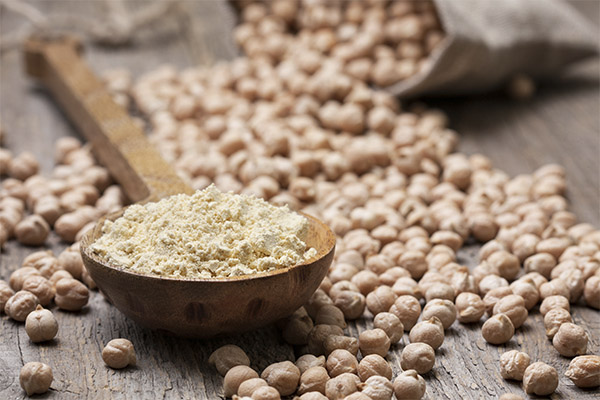
Even if a person just wants to bring his body to a normal state and start eating properly, Besan is the best assistant, as it has amazing dietary properties. They are caused, first of all, by the fact that this product has a very low glycemic index, which means that a priori it will not allow extra pounds to appear. Most world-famous nutritionists and fitness trainers unanimously recommend that everyone who wants to lose weight and start eating properly include in their diet chickpea meals. Naturally, this is not about buns and sugar-containing products, but about fresh pastries, various cereals, soups and other dishes. Therefore, it is worth paying closer attention to them.
Of course, continuing this topic, many are interested in the question, what kind of chickpea meal is recommended to eat during weight loss, so that they bring the most effective result. Many culinary chefs and nutritionists advise using besan as a breading mixture, which can be added during the preparation of various soups, stews, sauces and omelettes. You can also allow yourself to cook waffles, pancakes or pancakes several times a week, which, in addition to being very healthy, are also incredibly tasty. Of course, do not forget about fresh cakes from chickpea flour, which can quite easily replace the usual bakery products. From time to time you can treat yourself to delicacies such as fret balls or chickpea halva.
Chickpea flour in medicine
Since chickpea flour is rich in various vitamins, minerals, minerals and other useful substances, it is not surprising that it has a lot of healing properties and is actively used in folk medicine. This product is recommended to be actively added to everyday dishes:
- For disorders of the central nervous system, for example, during prolonged and deep depression, Parkinson's or Alzheimer's disease, as well as multiple sclerosis, schizophrenia, autism or SDF.
- Digestive diseases such as cirrhosis of the liver or fat damage, as well as some forms of hepatitis.
- Cardiovascular pathologies, for example, arrhythmias of early genesis, atherosclerosis, ischemia, stroke.
- Eye diseases such as glaucoma, cataracts, or a sharp decrease in visual acuity.
- Violation of the metabolic process in the body, which led to obesity, diabetes mellitus of varying severity or slow growth of the child.
- Problems with the musculoskeletal system - arthrosis, arthritis, osteoporosis or post-traumatic syndrome after serious injuries or even minor bruises and sprains.
- Pathologies of the autoimmune system, fermentopathy.
- Anemia, as well as heavy menstrual bleeding, including postpartum, metrorrhagia.
- Severe toxicosis or a serious delay in the intrauterine development of the baby.
- Various disorders of the genitourinary system, sexual dysfunctions, lack of erection, prostatitis, prostate adenoma and other diseases.
Among other things, it is also worth noting that Besan soup is very useful during the treatment of various respiratory diseases, such as pneumonia, bronchitis, laryngitis, tuberculosis, tracheitis or bronchiectasis. Due to the large number of active ingredients in its composition, chickpea flour helps to remove sputum from the respiratory system.
Also, due to the abundance of B vitamins in the chemical composition, this product effectively treats various skin diseases, such as eczema, dermatitis, seborrhea, various rashes or itching.
Due to the increased antioxidant properties, many modern doctors consider chickpea flour as a way to fight cancer cells, but this remains at the hypothesis level. Despite such an uncertain position of doctors, in folk medicine chickpea flour is actively used to treat various types of cancer in the early stages, in particular the gastrointestinal tract and the digestive system as a whole. It is especially recommended to include this product in your daily diet for those who are predisposed to cancer.
Chickpea flour in cosmetology
Chickpea flour is often used by oriental and Asian cosmetologists. This is not surprising, because it has a beneficial effect on both the skin and hair. On the basis of Besan, you can create various cleansing, brightening, matting and moisturizing masks for skin and hair, body scrubs, as well as compresses that will help get rid of minor scars and scars. In addition, this product can also be used for depilation.
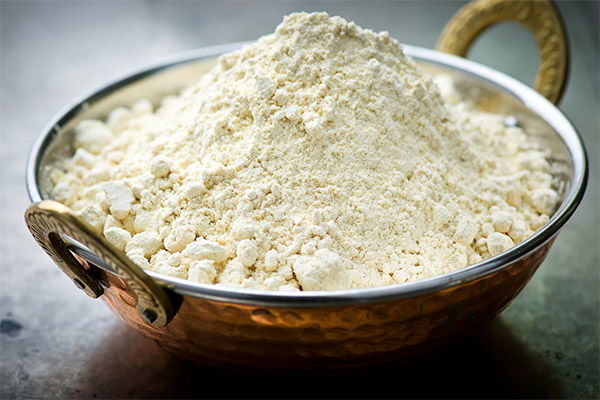
The most common and effective recipe for a Besan body scrub is quite simple:
- In the container, combine three parts of chickpea flour, two parts of corn and part of oatmeal.
- Add a little milk to this mixture and stir until a thick slurry.
- Apply to a damp, clean body, massage for five minutes with a washcloth, and then rinse with warm water.
- After the procedure, lubricate the skin with a moisturizer.
It is important to make this scrub immediately before use, as it tends to dry quickly.
The most popular and effective hair mask using chickpea flour is a mixture of Besan and cottage cheese in equal amounts, with the addition of lemon juice and one egg white. You need to apply it on damp clean hair and hold for 40 minutes, then rinse thoroughly under warm running water.
Harm and contraindications
No matter how useful chickpea flour, there are some contraindications that can not only harm the body, but even pose a serious threat:
- People prone to flatulence, diarrhea and other disorders of the gastrointestinal tract, it is necessary to reduce the use of Besan to a minimum or even abandon it.
- Those who suffer from food allergies should also be careful about consuming this product, as legumes themselves are strong allergens.
- In no case should you use besan for those who suffer from gastrointestinal ulcers, as well as acute kidney disease or thrombophlebitis, patients with gout should also refuse this product.
In general, there are no more contraindications, however, those who have not previously consumed chickpea flour as food, it is better to start doing it gradually, since this product is very specific.
How to store chickpea flour
If chickpea flour is purchased, then there will not be any special problems with storage, since it is often sold in special paper packaging. It should be stored in a dry place at room temperature so that the flour does not become damp and does not lose its beneficial properties. Such storage can last no more than a year, after which its use in food is highly not recommended.
If the packaging is opened, or the flour was made at home, it must be placed in an airtight container with a tight-fitting lid and stored in the refrigerator or freezer for no more than six months. If, after opening, store flour at room temperature, then its shelf life is reduced to one month.
How to make chickpea flour at home
There are only two ways to cook chickpea flour at home:
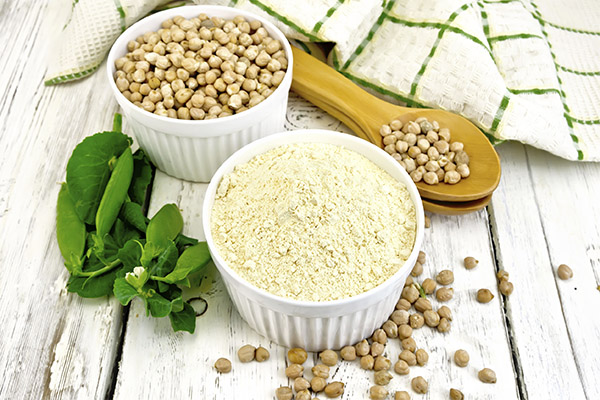
- Grind chickpeas in a coffee grinder and sift from large particles.
- Place the chickpeas in a preheated oven for a maximum of 15–20 minutes, then allow to cool, grind in a coffee grinder and sift.
The difference between these methods is that in the first case, flour is obtained that resembles raw peas to taste. It is well suited for lean and salty dishes, in particular cakes and soups. The flour prepared in the second way acquires a great flavor and aroma of walnut and is perfect for pastry and pastry.
What can be prepared from chickpea flour: recipes
Since chickpea flour has numerous beneficial qualities, it is not surprising that it is preferably added to food. That is why there are many kinds of recipes using this product. Each country has its own special dishes from chickpea flour, however, hummus and meatballs are considered the most common. They are especially fond of vegetarians, as they do not contain animal products.
- Hummus is a chickpea paste that is used as an appetizer. To prepare it, Besan mix well with water and put on a slow fire. When the mass boils and thickens, olive oil, garlic, salt, pepper and other seasonings are added to it to taste. The mixture is kept a little more on fire, then removed and allowed to cool, and then served to the table.
- Chickpea cutlets are cooked quite quickly and simply. It is necessary to mix grated carrots, chopped herbs, chickpea flour, salt and spices to taste, as well as pour a little water. Stir the mixture thoroughly, form the patties and fry in olive oil for three minutes on each side.
Interesting facts about chickpeas
- As you know, chickpeas were first cultivated as early as 7000 years ago in the Middle East, after which it quickly spread to Rome and Ancient Greece. Preferably, it was used for cooking cereals and soups, but after a while, chickpeas began to be made from chickpeas, which was used to prepare fresh baked goods and muffins.
- Since ancient times, people knew about the beneficial properties of chickpeas, and therefore dishes from this product were often used not only as ordinary food, but also for the treatment of various diseases, in particular pathologies of the lungs and male urogenital system. It was believed that dishes from chickpea flour help fight male impotence and increase potency.
«Important: all information on the site is provided exclusively in fact-finding purposes. Before applying any recommendations, consult with a profile specialist. Neither the editors nor the authors are liable for any possible harm caused materials. "

